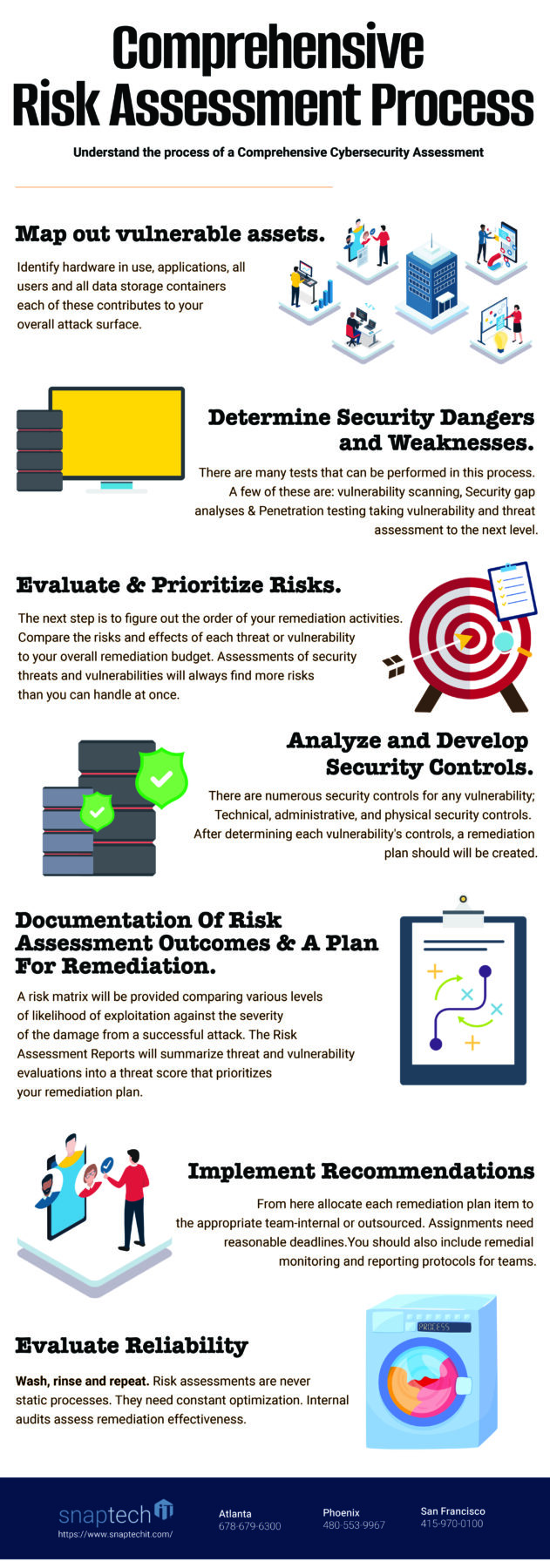Understand your Vulnerabilities
Assessments of security risk require a methodical approach that begins with knowing your critical security gaps. One of the best ways to identify those critical gaps is to complete a no-cost Rapid Security Snapshot that pinpoints top risk areas that leave your environment exposed to damaging cyber threats.
With your Rapid Security Snapshot, you’ll receive:
- A Snapshot Security Risk Overview
- Insights into high-risk areas for prioritization and further analysis
- Tips to neutralize identified high-risk areas
Use the Rapid Security Snapshot to understand major security issues in your environment & determine next steps for a comprehensive Cybersecurity Risk Assessment.

Frequently Asked Questions
How Do You Prepare For A Security Risk Assessment?
You should take several preliminary steps before conducting a security risk assessment. First, identify the purpose, scope and goals of the assessment, as well as any standards that you will use as a baseline. Second, identify all the key players in your organization that will participate in the assessment. Third, carefully select your assessment provider. Finally, set your desired timeline for completing the assessment.
Are Security Risk Assessments Required?
Unfortunately, the answer is “It depends.”
Perhaps your industry has requirements, or you work with a partner that requires security assessments (e.g, CMMC). Or maybe you are subject to specific regulations like the HIPAA Security Rule. Or you may be concerned about compliance with privacy laws like the California Consumer Privacy Act. But even if security risk assessments are not required, it is a good business practice to conduct them.
How Often Should A Security Risk Assessments Be Performed?
It depends on the nature of your business and the security requirements within your industry. HIPAA, for instance, requires periodic evaluation of security measures, although it does not define the period. As a best practice, PurpleSec recommends performing a security risk assessment at least annually. You should also conduct security assessments when there are significant changes to the laws and regulations that affect your business, as well as when you make changes to your networks, systems or external providers. Acquisitions and mergers are also excellent opportunities to revisit your security assessments.
How Long Does It Take To Conduct A Security Risk Assessment?
The time necessary to complete a security risk assessment can range from several days to several weeks or months. Several factors impact the time it takes to conduct a risk assessment, including:
- The scope of the assessment
- The size of your organization and the number of systems involved
- The number of tests in the assessment
- The tools or providers used in performing the assessment
Who Is Responsible For Security Risks?
Every single member of your organization has some degree of responsibility for security, although the buck stops at the C-suite. It is crucial to train employees on security policies and procedures so that they can adequately fulfill their security roles. It is equally crucial for the C-suite to lead by example with respect to security – setting, following and enforcing policies that build an organizational culture focused on security. Organizations must also remember that when they use external service providers (IaaS, PaaS, SaaS or others), there is always some degree of shared responsibility for security.
How Much Does A Security Risk Assessment Cost?
Just as with timelines, the costs for a security risk assessment can vary substantially, ranging from several thousand dollars to tens of thousands of dollars. Factors that affect the cost of a security risk assessment include:
- The scope of the assessment
- The number of tests to be run
- The number of systems and users involved
- The speed with which the assessment must be completed
While security risk assessments are not cheap, their cost is invariably much less than the cost of a breach.
What’s The Difference Between A Security Risk Assessment And A Threat Assessment?
A risk assessment is more comprehensive than a threat assessment. Threat assessments identify things that can exploit vulnerabilities, including malicious external actors, inside actors and even unintentional actors. Risk assessments identify all assets, their associated vulnerabilities, the threats that can exploit those vulnerabilities, and, importantly, the damage to assets and the company resulting from a successful exploit.
What’s The Difference Between A Security Risk Assessments And A GAP Analysis?
A gap analysis is just one piece of an overall security risk assessment. A security gap assessment focuses on administrative controls and configuration concerns, compares an organization’s current security posture to one or more security standards.
What Security Risk Assessment Tools Are Available?
There are a wide range of risk assessment software tools available that can facilitate many of the risk assessment process steps. Among these are network scanners, protocol scanners, web application scanners, attack simulation tools, penetration testing tools and more. In addition, if you use third-party experts for your risk assessments, they may have their own proprietary testing tools.
Does Security Risk Assessment Prevent Ransomware Attack From Occurring?
While there are no tools that can completely prevent ransomware attacks, security risk assessments followed with strong remediation efforts can strengthen your systems against such attacks. Moreover, security risk assessments can help you identify processes and procedures to put in place to mitigate the effects of a ransomware attack, including setting up redundant backups.